A lot of people are asking how to take measurements and make 3D models from 2D images. If conditions are juuusst right, SketchUp’s Match Photo technique is the way to go. Unfortunately, in our world, conditions are almost never just right, unless you happen to be able to take the photo yourself. Here’s an alternative method using Web Plot Digitizer, which is still free and can scale for as much (or as little) information as you have (keeping in mind a greater margin of error).
A few days ago the DPRK’s state news agency, KCNA released the first images of North Korea’s new submarine launched ballistic missile (SLBM). These photos we’re great, but with just sky and water, there wasn’t much context about the size of the missile.
That is until one of our eagle-eyed research assistants, Dave Schmerler, spotted this:
BOOM! and, we were off running (well, typing furiously on a JFK-> SFO flight). Surprise! That carefully crafted message of Kim Jong Un hanging on his yacht smoking a cigarette and watching a missile launch from a submarine? Not so much. Turns out they start off launching from an underwater platform just like the rest of us.
So, to the measurements:
1) Geolocate the ship!
Dave already took care for that for us. It’s in Sinpo! (40.026008°, 128.166174°) Using the measurement tool in Google Earth, we can see that from stern to cabin, the ship is about ~10.03 meters.
2) Load the screen shot from YouTube into Web Plot Digitizer
Load in the very best screen shot you can muster from the YouTube video which shows both the missile and the ship. Next, choose the “Map With Scale Bar” option, and hit “Align Axes.” So… we don’t actually have a map with a scale bar, but we are going to simulate one. And, because the entire ship isn’t in the image, we are going to use the distance from the stern to the cabin as our scale.
Zoom in as much as is comfortable, and use the window in the top right to place your points. You can adjust them as needed. I measured along the top of the water to keep things level. When ready, click “Complete!” and enter the units. I measured 10.03 meters on Google Earth, so that’s what I put in.
3) Measure!
Under the Analyze tab you will find the “Measure Distances” option. Select it and make sure “Add a Pair (A)” is highlighted. Again, zoom in as much as is comfortable, and use the window in the top right to place your points. If you want to start over you can “Delete a Pair” or “Clear All.”
I did this several times, and got slightly different measurements, but they were all around 9 meters long with 1.5 diameter. There is a kind of faint halo that forms around the missile, and I tended to discount it in the measurements. I’d be interested to see what measurements others get, so that maybe we could average them. This rough estimate makes it seem like they are working from an R-27.
Using a higher resolution image of the missile (which, unfortunately, doesn’t have the ship for scale) I got a ratio of 90.64 to 14.95 pixels.
Hey! Dave even made a great 3D model for NTI! Check it out:
4) The Fine Print
Like it says in the title, these are just back of the envelope calculations. Please don’t set your ballistic missile defense to it 😉
First and foremost, these aren’t very high res images. And, taking a screenshot of a YouTube video of a still image, is kind of scraping the bottom of the barrel. A pixel here and a pixel there on a low resolution image can add up. On top of that, we don’t know the distance or heading of either the ship or the missile relative to the camera or each other, which causes a greater margin of error.
Another fantastic research assistant, Bo Kim, will write up a more detailed account of how to use this process to measure Iranian centrifuges taking into account their angle relative to the camera. STAY TUNED!

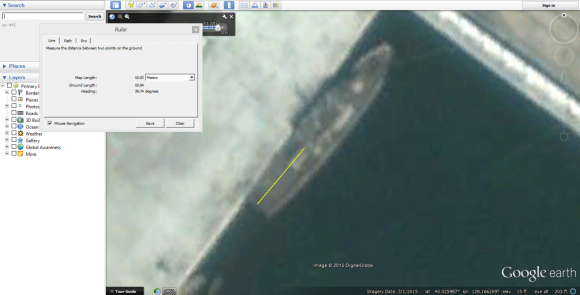
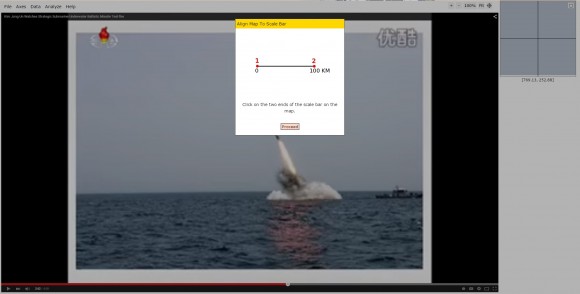
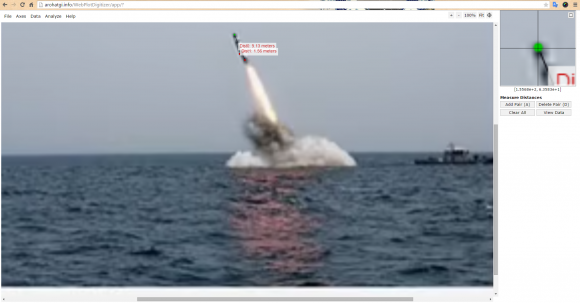
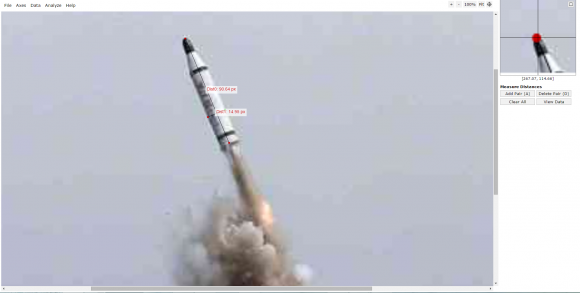
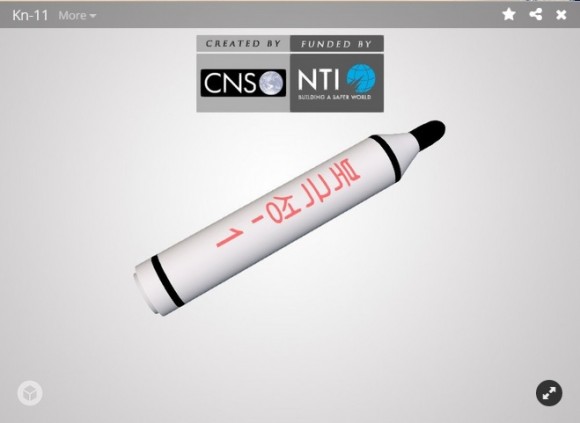

FYI – I did approximately the same thing with the sail width of the Sinpo sub, to see if it could credibly have sail tubes for 1.5 meter missiles. The sailors on deck provided a 165.5 centimeter-stick, assuming they are average height North Koreans comparable to the defectors measured in the west. The sail came out 214 cm wide best match, though I could see +- 5% off that.
See: http://i.imgur.com/W34ucon.png
Unknown unknown is the actual true height of Comrade Sailor Closest to Sail. But he seemed in proportion to the others on the deck.
Awesome! Can’t wait to get some more images to play with!
Very nice work. The missile body is indeed looking like an R-27 in size and shape.
The plume is another matter. I make it about 17 meters long, two meters maximum diameter, bright opaque yellow to yellow-orange, with minimal smoke.
Compare this,this, and this; tests of Iranian Shahab and Pakistani Ghauri missiles using DPRK-sourced Nodong engines. The missile bodies are 18 meters long and 1.25 meter diameter. Pretty good match.
There’s no good imagery of an R-27 in flight that I know of, but it uses UDMH fuel to the Nodong’s kerosene. Here are some other UDMH engines; the slightly smaller American Lance and the much larger US Titan and Russian Proton. Translucent pinkish-white flame, not even close.
So, a Nodong engine in an R-27-ish body. Makes sense for an ejection test; no sense using a scarce and presently unreliable R-27 engine for a brief burn in an ejection-system test. But is that the plan for the operational KN-11, or just a kludge for the early tests?
Alternately, either the plume or the missile body is wholly photoshopped; I lean against that interpretation but I don’t have the tools or expertise for an expert opinion.
Thank you. I did not see hypergols in that exhaust plume either but was pooh-poohed.
John,
Perhaps the color differences indicate different propellants?
As for the shape of the plume, in the two “Polaris-1” photos at 3:15 and just afterward in the video, once the missile is clear of the water, it looks generally like the plumes in the Nodong-type launches you link to.
There’s a prominent smoke trail in the photo at 3:38, which is taken from almost underneath the rising missile, maybe from the small boat seen in the photo at 2:52. Perhaps that’s a matter of perspective?
I’m not sure you’ve identified clear evidence of falsification.
John,
Sorry – I read too fast and misunderstood.
A Nodong engine – could be. On the other hand, the black-and-white video located by “sineva,” below, shows the SS-N-6 exhibiting a plume shape and non-translucency fairly consistent with what we see here. I’m not sure why it should be so different from the Lance and Proton pictures you found. More work to do…
repeating my prior comment for effect:
I can state the smoke color is slightly less reddish than the IFRNA/Kerosene (and starter) products I observed in flight test that is characteristic of the R-17, R-11 and R-13 families. Details of mixing, ignition transient, stabilizers and such matter sufficiently that you cannot reliably type fuels & oxidizers among the nitrogen containing oxidizer families.
I`ve found some footage of a ssn6 launch here,its in b+w but shows a surface launch from the test barge as well as a submerged launch
https://www.youtube.com/watch?v=6DcZ6wL2_Lc
Measuration is fine; where is the error analysis and underlying assumptions called out? If we suspect that photo alterations in source occurred then additional diligence of analytic basis is called for.
1) ID of reference in frame; while attractive as a hypothesis, can it be stated with quantified confidence that the ship near the sub in the overheads is the ship supposedly in the photo (adding a ship for ‘window dressing’ photoshopped into the image is or is not plausible?) The apparent distance from the launch event is inherently within the hazard zone. The appearance of the ‘young general’ in the hazard zone causes us to suspect that image. The locus of the apparent sun for all shadows in the image should match and the apparent plume reflection in this image was pointedly IDed as off by Schiller.
2) Perspective; I note the innate assumption the ship is equally distant from the observer. What is the error tolerance on this assumption? Near-orthogonal view on ships long axis may be explicitly assumed – what’s the error tolerance on this assumption?
3) Significant figures and pixel counting; what explicitly defines your edges? I expect shading definitions for pixel fill fractions and accounting for issues such as ‘limb darkening’ on curved surfaces viewed. Overall unless you control the camera and calibrate well estimates below single pixel error tolerances are not appropriate.
Some meta-environment supporting data would help; for the stated/claimed test location and date – what was the cloud cover like?
Finally a roll up of the errors in measuration and the full assumption set should show up in “the ratio of 90.64 to 14.95 pixels” as stated.
Dear Melissa,
This is a really nice article.
I really like your posts. They are a welcome departure from the usual political stuff one sees here.
Please keep up the good work.
Best Regards
Uban
available pics show two distinct different sea tests:
a) from underwater test platform (most probably first sea popup test);
b) from submerged sub (probably first sea flight test).
Hi Melissa
This is bullshit! That is a very badly done photoshop!
There is no such thing as a SLBM launch in NK!.
You have all been duped
Is that ship a tugboat or an observation boat?
The ship in the satellite photo looks like a small warship.
The North Koreans already succeeded in launching SLBM from an underwater test platform.
http://www.abovetopsecret.com/forum/thread1066426/pg1
http://freebeacon.com/national-security/u-s-spy-agencies-closely-watched-n-korea-underwater-missile-test/
See above articles!
Last October, January,April and February?
The satellite photo of 10th May shows two missile canisters crossed on the ground.It means the two canisters are empty. So we can conclude that the North Koreans launched two SLBMs(dummy or not)from the SSB on that day.
…According to US defense officials cited by the Washington Free Beacon on Tuesday, the test took place on April 22 from an underwater test platform near the coastal city of Sinpo in the southeast of the country, and tested what the US is calling a KN-11 missile.
The test appears to have been successful, and is the third KN-11 test showing the high-priority of the nuclear missile program for North Korea. Previous tests in January and last October were from a sea-based platform not underwater and a land-based platform…
..U.S. officials have said the new SLBM has been under development since last year, but the first official confirmation of the new weapon came during congressional testimony in March by U.S. Strategic Command commander Adm. Cecil Haney.
The missile was flight tested in February and the Pentagon has designated the new system as the KN-11…
Washington freebeacon
Melissa,
Please consider starting a thread to prove this was not (was) a tactical nuke. I believe it is a fuel/air explosion by the look. There are plenty of things to measure in this video, i.e. frame by frame velocities of the expanding fireball. I think it is most AC wonky and similar to your skill set.
http://www.globalresearch.ca/the-war-on-yemen-americas-plans-to-use-nuclear-weapons-against-the-middle-east/5453065
http://www.liveleak.com/view?i=fdf_1432986955